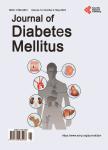12/15-Lipoxygenase inhibition counteracts MAPK phosphorylation in mouse and cell culture models of diabetic peripheral neuropathy
12/15-Lipoxygenase inhibition counteracts MAPK phosphorylation in mouse and cell culture models of diabetic peripheral neuropathy作者机构:Department of Internal Medicine Eastern Virginia Medical School Norfolk USA Department of Veterans Affairs Iowa City Health Care System and Department of Internal Medicine University of Iowa Iowa City USA Pennington Biomedical Research Center Louisiana State University System Baton Rouge USA
出 版 物:《Journal of Diabetes Mellitus》 (糖尿病(英文))
年 卷 期:2013年第3卷第3期
页 面:101-110页
学科分类:1002[医学-临床医学] 100214[医学-肿瘤学] 10[医学]
主 题:Diabetes Lipoxygenase Neuropathy Schwann Cells Mitogen-Activated Protein Kinase
摘 要:Background: Increased mitogen-activated protein kinase (MAPK) phosphorylation has been detected in peripheral nerve of human subjects and animal models with diabetes as well as high-glucose exposed human Schwann cells, and have been implicated in diabetic peripheral neuropathy. In our recent studies, leukocytetype 12/15-lipoxygenase inhibition or gene deficiency alleviated large and small nerve fiber dysfunction, but not intraepidermal nerve fiber loss in streptozotocin-diabetic mice. Methods: To address a mechanism we evaluated the potential for pharmacological 12/15-lipoxygenase inhibition to counteract excessive MAPK phosphorylation in mouse and cell culture models of diabetic neuropathy. C57Bl6/J mice were made diabetic with streptozotocin and maintained with or without the 12/15-lipoxygenase inhibitor cinnamyl-3,4-dihydroxy-α-cyanocinnamate (CDC). Human Schwann cells were cultured in5.5 mMor30 mMglucose with or without CDC. Results: 12(S) HETE concentrations (ELISA), as well as 12/15-lipoxygenase expression and p38 MAPK, ERK, and SAPK/JNK phosphorylation (all by Western blot analysis) were increased in the peripheral nerve and spinal cord of diabetic mice as well as in high glucose-exposed human Schwann cells. CDC counteracted diabetes-induced increase in 12(S)HETE concentrations (a measure of 12/15-lipoxygenase activity), but not 12/15-lipoxygenase overexpression, in sciatic nerve and spinal cord. The inhibitor blunted excessive p38 MAPK and ERK, but not SAPK/ JNK, phosphorylation in sciatic nerve and high glucose exposed human Schwann cells, but did not affect MAPK, ERK, and SAPK/JNK phosphorylation in spinal cord. Conclusion: 12/15-lipoxygenase inhibition counteracts diabetes related MAPK phosphorylation in mouse and cell culture models of diabetic neuropathy and implies that 12/15-lipoxygenase inhibitors may be an effective treatment for diabetic peripheral neuropathy.



